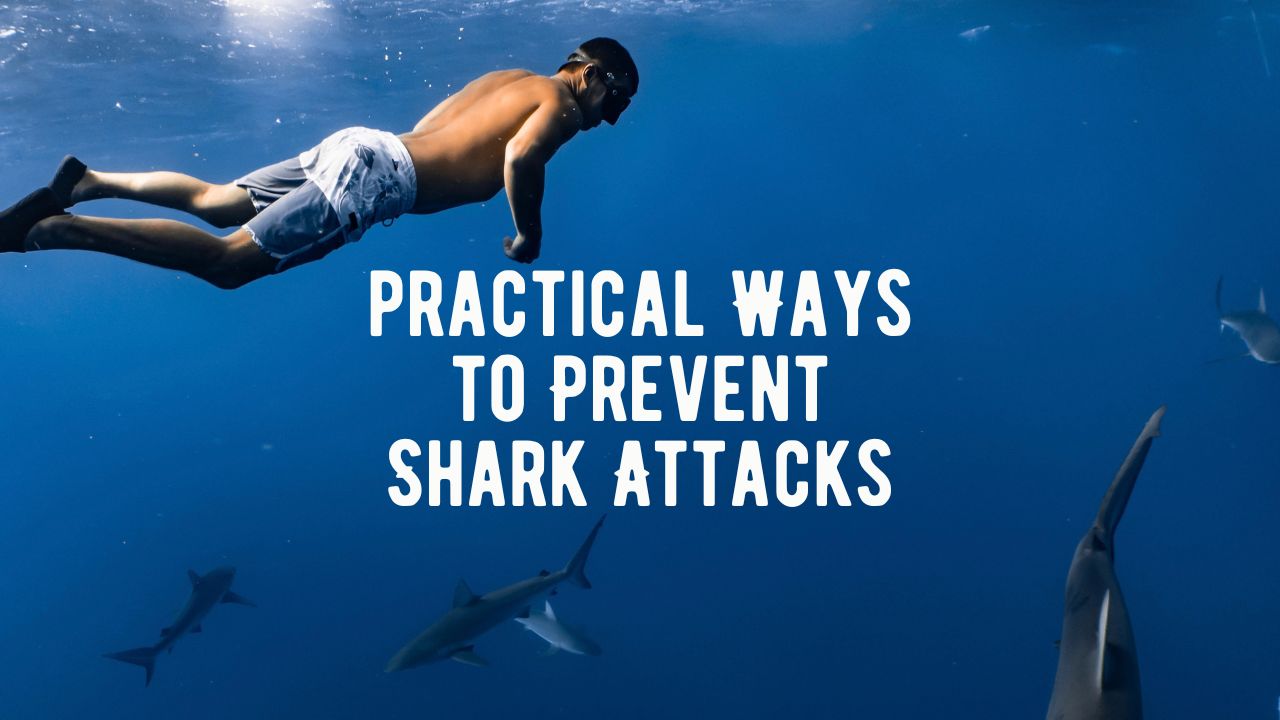
Sharks are magnificent creatures, and while shark attacks are extremely rare, it’s essential to be aware of preventive measures to ensure human safety. In this comprehensive guide, we will explore various ways to prevent shark attacks, debunk common myths, and provide practical tips for ocean enthusiasts.
Shark attacks capture headlines, often overshadowing the fact that sharks play a crucial role in maintaining the balance of marine ecosystems. Understanding how to coexist safely with these apex predators is vital for both human safety and marine conservation.
Table of Contents
ToggleUnderstanding Shark Behavior
Shark Species and Their Behavior
Not all sharks are the same, and understanding the behavior of different species is essential. While some sharks are known for their docile nature, others may exhibit more aggressive tendencies. Knowledge about the species prevalent in specific regions helps inform safety measures.
Environmental Factors
Shark behavior is influenced by environmental factors such as water temperature, visibility, and prey availability. Being aware of these factors can aid in predicting when sharks might be more active and adjusting activities accordingly.
Human Behavior
Human actions, knowingly or unknowingly, can contribute to shark-human encounters. Activities like spearfishing and the presence of schools of fish can attract sharks. Responsible behavior in the water is key to reducing the risk of shark attacks.
Myths About Shark Attacks
Before delving into preventive measures, let’s debunk some common myths surrounding shark attacks:
Myth 1: Sharks Are Mindless Killers
Reality: Sharks do not target humans as prey. Most attacks are cases of mistaken identity, with sharks confusing surfers or swimmers with their usual prey.
Myth 2: Shark Nets Make Beaches Safe
Reality: Shark nets are not foolproof. They can entangle other marine species and give a false sense of security. Moreover, some sharks can swim over or around these nets.
Myth 3: Sharks Are Always Aggressive
Reality: Sharks are generally cautious and curious. Unprovoked attacks are rare, and sharks often investigate unfamiliar objects with a “test bite” rather than intending harm.
Practical Tips to Prevent Shark Attacks
Now, let’s explore practical ways to minimize the risk of shark encounters:
1. Be Mindful of Your Surroundings
- Avoid Dusk and Dawn: Sharks are more active during low-light hours. Refrain from being in the water during dawn or dusk.
- Steer Clear of Rivermouths and Stream Outlets: These areas attract baitfish, a potential food source for sharks.
- Stay Away After Rain: Rain can wash debris and potential shark prey into the ocean, attracting sharks.
2. Choose Your Swimming Location Wisely
- Avoid heavily fished areas: Fishermen and their activities can attract sharks. Stay away from areas with active fishing.
- Avoid Fishing Areas: Sharks are attracted to fishing activity. Be cautious around areas used by anglers.
3. Understand Shark Behavior
- Swim in Groups: Sharks are more likely to approach solitary individuals. Stick to swimming in groups.
- Stay Calm If You Encounter a Shark: Avoid rapid movements and maintain a vertical position. Sharks may lose interest if they realize you’re not prey.
- Urinate Away from the Ocean: While the idea that urine attracts sharks is debatable, avoiding urination in the ocean is a precautionary measure some suggest.
4. Personal Habits and Precautions
- Mind Open Wounds: Sharks may be attracted to the smell of blood. Refrain from entering the water with open wounds.
- Consider Menstrual Cycle Impact: Some believe sharks can detect menstrual blood, although evidence is inconclusive. It’s a personal choice, but some recommend avoiding ocean activities during menstruation.
- Avoid Shiny Jewelry: Reflective jewelry can resemble fish scales. Sharks may investigate shiny objects, so leaving them at home is advisable.
5. Use Shark Repellents
- Consider Repellent Devices: Various repellents emit electrical pulses or odors to deter sharks. Explore options like bracelets, anklets, or surfboard wax.
6. General Water Safety Tips
- Stay Close to the Shore: Avoid venturing too far from the shore. Emergency assistance is more accessible near the shore.
- Avoid Murky Waters: Sharks may have difficulty distinguishing objects in murky water. Exercise caution in such conditions.
7. Be Wary of Wildlife Signs
- Watch for Dolphins and Porpoises: While these marine animals are beautiful, they do not indicate the absence of sharks. Sharks and dolphins can share the same habitat.
8. Minimize Splashing and Noise
- Reduce Splashing: Sharks can detect low-frequency sounds from splashing. Minimize excessive splashing, which may attract their attention.
9. Evacuate the Water If Sharks Are Present
- Exit the Water Calmly: If sharks are spotted, calmly and slowly leave the water. Avoid sudden movements that might attract attention.
Mitigating the Risk of Shark Attacks
Technological Solutions
Advancements in technology offer tools for minimizing the risk of shark attacks. Shark detection systems, drones, and smartphone apps provide real-time information about shark sightings, allowing beachgoers to make informed decisions.
Personal Precautions
Individuals can take proactive measures to reduce the likelihood of shark encounters. These include avoiding areas known for shark activity, refraining from wearing shiny jewelry in the water, and adhering to local safety guidelines.
Community and Government Initiatives
Communities and governments play a vital role in implementing policies and initiatives to enhance safety. Lifeguard training, beach signage, and public awareness campaigns contribute to creating a safer environment for beach enthusiasts.
Promoting Coexistence
Conservation and Education
Conservation efforts aimed at protecting shark populations contribute to a healthier marine ecosystem. Educating the public about the importance of sharks and dispelling myths can foster a greater appreciation for these creatures.
Research and Monitoring
Ongoing research and monitoring initiatives help scientists better understand shark behavior and migration patterns. This knowledge is invaluable for implementing effective safety measures and conservation strategies.
Legislation and Policy
Enacting and enforcing legislation related to shark protection and responsible tourism is critical. Fishing regulations, marine reserves, and policies addressing shark finning are essential components of comprehensive shark conservation.
Conclusion
Shark attacks are statistically rare, but being informed and following preventive measures ensures a safer coexistence between humans and sharks. By understanding shark behavior and adopting responsible ocean practices, we contribute to both personal safety and marine conservation efforts. Always remember, sharks are essential for healthy oceans, and respectful coexistence is key.
FAQs: Understanding Shark-Human Interactions
Q1: How common are shark attacks?
Shark attacks are extremely rare, with only a few incidents reported globally each year.
Q2: Are certain shark species more dangerous?
While some species may be involved in more incidents, sharks are generally not aggressive toward humans.
Q3: Can sharks smell blood from miles away?
Sharks have a highly developed sense of smell but cannot detect blood from miles away. The exact distance varies by species.
Q4: Do shark repellents work?
Shark repellents can be effective, but their success varies. Some emit electrical pulses, while others use odors to deter sharks.
Q5: Why do sharks attack humans?
Sharks may mistake humans for prey or react defensively. Unprovoked attacks are rare, and sharks typically avoid human encounters.
Q6: Are there certain times of the year when shark attacks are more likely?
Shark activity can vary by location and species. In some areas, attacks may be more common during specific seasons.
Q7: Should I punch a shark in the nose if attacked?
Contrary to popular belief, punching a shark in the nose is not always the most effective response. Focus on defending yourself and getting to safety.
Q8: Can sharks hear human screams?
Sharks have an acute sense of hearing, but the effectiveness of screams as a deterrent is uncertain.
Q9: Do shiny objects attract sharks?
Shiny jewelry can potentially attract sharks due to light reflections, resembling the sheen of fish scales.
Q10: What should I do if I encounter a shark?
Remaining calm is crucial in a shark encounter. Avoid sudden movements, maintain eye contact, and slowly back away. If a shark behaves aggressively, using any available protective barrier is advisable.
Q11: How common are shark attacks?
Shark attacks are relatively rare, with only a few incidents reported globally each year. The likelihood of a shark attack depends on various factors, including geographic location and human behavior.
Q12: Can sharks be trained to avoid humans?
While sharks are intelligent creatures, training them to avoid humans is not a feasible solution. It is more effective for humans to adopt behaviors that reduce the risk of shark encounters.
Q13: Do certain colors attract sharks?
There is limited evidence to suggest that specific colors may attract sharks. However, the contrast between light and dark colors might be more visible to sharks in certain conditions.






